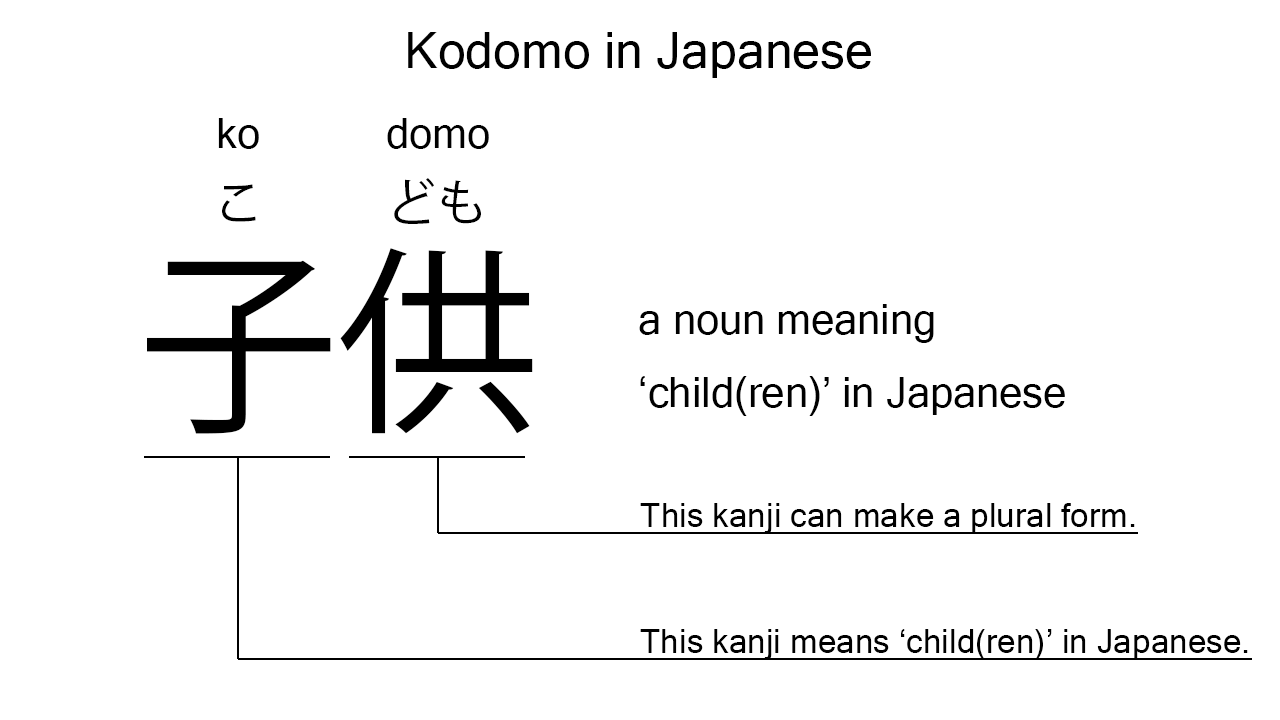What does “kodomo” mean in Japanese?
Native speakers use kodomo normally to mean a ‘child’ in Japanese. Perhaps, some Japanese learners know this word as it is sometimes used in Japanese conversations. In this blog post, however, I will explain this word in detail based on its kanji expression. And also, I will explain how to use it through example sentences. My explanations would help Japanese learners understand kodomo more clearly. Then, let’s get started!
Contents
Definition and meanings of “kodomo”
Let me start with the definition and meanings of kodomo.
- kodomo – 子供 (こども) : a noun meaning a ‘child’ or ‘kid’ in Japanese. This can also work as plural. Learn more about Japanese plural.
Native speakers use this noun to refer to someone who is not yet fully grown. So, the usage of this noun is similar to those of the English ones written above.
The definition and meanings are simple and clear. To understand this noun more clearly, however, let me explain its kanji characters in detail, one by one.
Kodomo in kanji
The kanji expression of kodomo consists of the following two kanji characters:
- 子 : a kanji character widely used to mean a ‘child’ or ‘kid’ in Japanese.
- 供 : a kanji character often used as a suffix to make the plural form of its preceding word.
From these two kanji characters, we can understand that the formed noun literally means ‘children’ or ‘kids’ in Japanese. This literal interpretation is completely in line with the actual meanings. As the kanji expression suggests, this noun was originally a plural. Today, however, Japanese people use this also as a singular. As times change, Japanese plural nouns often revert to singulars.

When we meet new kanji expressions, we should check their kanji characters in detail to understand their meanings clearly and deeply. In many cases, kanji characters tell us a lot about the meanings of the expressions they form. Actually, here, we could get the better understanding of kodomo through the detailed kanji check above.
So far, I’ve explained the definition and meanings of kodomo together with its kanji characters. Then, let me explain how to use it through the example sentences below.
How to say “children” in Japanese
kanojo wa kodomo ga suki desu – 彼女は子供が好きです (かのじょはこどもがすきです)
She loves children.
Below are the new words used in the example sentence.
- kanojo – 彼女 (かのじょ) : a pronoun meaning ‘she’ in Japanese.
- wa – は : a binding particle working as a case marker or topic marker. In the example, this works after kanojo to make the subject in the sentence.
- ga – が : a case particle used to make the subject word or the object word in a sentence. In the example, this is used after kodomo to make the object in the sentence.
- suki – 好き (すき) : the stem part of the na-adjective, sukina, which means ‘favorite’ in Japanese. Native speakers, however, often use this as an individual word to mean ‘to like’ or ‘to love’ in Japanese. In the example, this is used to mean ‘to love’ in Japanese.
- desu – です : an auxiliary verb used after a noun or adjective to make it polite. Probably, this is well known as a part of Japanese desu form. In the example, this is used after suki to make it sound polite.
This is a typical usage of kodomo. In this example, it works together with the case particle, ga, to become the object in the sentence.
Another example of “kodomo”
karera wa mada chiisai kodomo desu – 彼等はまだ小さい子供です (かれらはまだちいさいこどもです)
They are still young kids.
Below are the new words used in the example sentence.
- karera – 彼等 (かれら) : a pronoun meaning ‘they’ in Japanese.
- mada – まだ : an adverb meaning ‘still’ in Japanese.
- chiisai – 小さい (ちいさい) : an i-adjective meaning ‘small’ in Japanese. In this example, this has been translated as ‘young’, though.
This is another example of kodomo. In this example, it works together with the i-adjective, chiisai, to mean ‘young kids’ in Japanese. When we want to refer to someone who is not yet fully grown in Japanese, anyway, this noun is always a very good option.
Summary
In this blog post, I’ve explained the definition and meanings of kodomo in detail based on its kanji expression. And also, I’ve explained how to use it through the example sentences. Let me summarize them as follows.
- kodomo – 子供 (こども) : a noun meaning a ‘child’ or ‘kid’ in Japanese. This can also work as plural. These two kanji characters literally mean ‘children’ or ‘kids’ in Japanese. This literal interpretation is completely in line with the actual meanings. As the kanji expression suggests, this noun was originally a plural. Today, however, Japanese people use this also as a singular. As times change, Japanese plural nouns often revert to singulars.
Hope my explanations are understandable and helpful for Japanese learners.
Leave a Reply